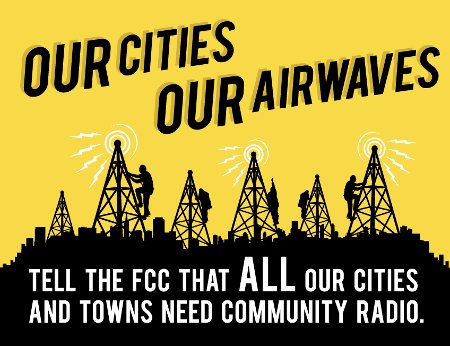Two clicks on the dial: the fight for urban community radio continues
 The FCC has proposed rules to expand low power community radio into urban areas, asking the public to comment by May 7. But the same commercial broadcast lobby that blocked the Local Community Radio Act for the better part of a decade is still at it. To beat them again, we have to make our voices heard.
The FCC has proposed rules to expand low power community radio into urban areas, asking the public to comment by May 7. But the same commercial broadcast lobby that blocked the Local Community Radio Act for the better part of a decade is still at it. To beat them again, we have to make our voices heard.
What’s at stake
At its simplest, the issue is whether new low power FM (LPFM) stations must be at least three clicks on the dial away from existing stations, or whether LPFM stations can be just two clicks away, using “second adjacent channel waivers.” Getting to broadcast just three clicks away from other stations (on the “third adjacent channel”) was the hard won victory of the Local Community Radio Act, opening many cities to community radio. But for many other cities, where the dial is more crowded, three clicks away is too much, keeping community radio locked out. (Watch our four-minute video for a visual breakdown).
Fortunately, the Local Community Radio Act also authorized the FCC to license low power stations just two clicks away from other stations, waiving the rules on second adjacent frequencies, as long as the LPFMs won’t cause interference to neighboring stations. This could allow new community radio stations in urban areas, doubling or tripling the number of channels available nationwide! (Find out if your community would require a second adjacent frequency waiver with our zip code lookup and check out our national radio forecast maps.)
Broadcast lobby at it again
The bad news is that commercial broadcasters think they own the radio spectrum, and they won’t give up a sliver without a fight. Last week, a spokesperson for the National Association of Broadcasters said they “have concerns that waiving protections for second adjacent channels will result in very real and very serious interference for millions of radio listeners.”
These concerns aren’t based in reality. In fact, FM translators (which are repeater stations that often operate at higher power than LPFM) already waive second adjacent channel rules, and they have been doing so for years. The same laws of physics apply to LPFM. The only difference is that translators are owned by incumbent broadcasters, and they want everyone else to play by a different set of rules.
Even if interference was a real concern, the Local Community Radio Act includes tough new rules to protect full power broadcasters from potential interference (however unlikely) caused by LPFM stations using second adjacent waivers. The law even requires LPFM stations that do cause interference to go off the air until the problem is resolved. So the broadcast lobby has no excuse for shutting out community radio.
Tell the FCC
We know the FCC will be hearing from commercial broadcasters. They also need to hear from our communities. The deadline for public comment is Monday, May 7. Send a comment at our Take Action page or use the zip code tool to send a personalized comment based on your zip code (just click “Tell the FCC” on your results page).
